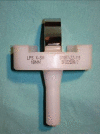Failure rate of a rotating hinge knee design due to yoke fracture of the hinged tibial insert: a retrospective data analysis and review of the literature
- PMID: 22202962
- PMCID: PMC3337105
- DOI: 10.1007/s00264-011-1462-9
Failure rate of a rotating hinge knee design due to yoke fracture of the hinged tibial insert: a retrospective data analysis and review of the literature
Abstract
Purpose: Rotating hinge knee prostheses are known to provide inherent stability. Yoke fractures of the hinged tibial insert of modern generation rotating hinge devices are a matter of continued concern. The aim of this study was to describe incidence and management of yoke fracture of the LPS™ hinged tibial insert.
Methods: Retrospective data analysis of two institutions identified 40 patients with a LPS™ total knee arthroplasty. Implant survival and prosthetic complications was calculated according to Kaplan-Meier.
Results: Out of the group of 40 patients, four fractures of the metal yoke occurred in four cases (failure rate: 10%). Furthermore, a second fracture occurred in two patients. The overall revision-free prosthetic survival was 57% at 38 months, while prosthetic survival until yoke fracture was 86% at 38 months.
Conclusion: Handling yoke fractures as mechanical complication includes replacing the hinged insert, stabilization of the joint and joint line height preservation in order to decrease the cantilever effect at the insert-base plate interface.
Figures




Similar articles
-
Rotating-hinge prosthesis for aseptic revision knee arthroplasty: A multicentre retrospective study of 127 cases with a mean follow-up of five years.Orthop Traumatol Surg Res. 2021 May;107(3):102855. doi: 10.1016/j.otsr.2021.102855. Epub 2021 Feb 10. Orthop Traumatol Surg Res. 2021. PMID: 33581278
-
Failure of the tibial insert in a rotating hinge total knee arthroplasty.J Arthroplasty. 2011 Sep;26(6):977.e5-8. doi: 10.1016/j.arth.2010.08.008. Epub 2010 Sep 25. J Arthroplasty. 2011. PMID: 20870381
-
Rotating Hinge Implants for Complex Primary and Revision Total Knee Arthroplasty.J Arthroplasty. 2018 Mar;33(3):766-770. doi: 10.1016/j.arth.2017.10.009. Epub 2017 Oct 16. J Arthroplasty. 2018. PMID: 29129618
-
Complications and failures of non-tumoral hinged total knee arthroplasty in primary and aseptic revision surgery: A review of 290 cases.Orthop Traumatol Surg Res. 2021 May;107(3):102875. doi: 10.1016/j.otsr.2021.102875. Epub 2021 Feb 27. Orthop Traumatol Surg Res. 2021. PMID: 33652151 Review.
-
Rotating-hinge knee prosthesis as a viable option in primary surgery: Literature review & meta-analysis.Orthop Traumatol Surg Res. 2019 Nov;105(7):1351-1359. doi: 10.1016/j.otsr.2019.08.012. Epub 2019 Oct 3. Orthop Traumatol Surg Res. 2019. PMID: 31588033 Review.
Cited by
-
Mechanical Failure of Modular Rotating Hinge Femoral Component.Arthroplast Today. 2024 Oct 16;30:101495. doi: 10.1016/j.artd.2024.101495. eCollection 2024 Dec. Arthroplast Today. 2024. PMID: 39492995 Free PMC article.
-
Dislocation of rotating-hinge total knee arthroplasty.EFORT Open Rev. 2021 Feb 1;6(2):107-112. doi: 10.1302/2058-5241.6.200093. eCollection 2021 Feb. EFORT Open Rev. 2021. PMID: 33828853 Free PMC article. Review.
-
Posterior dislocation of the hinge-post extension in a rotating hinge total knee prosthesis.Case Rep Orthop. 2013;2013:756538. doi: 10.1155/2013/756538. Epub 2013 Sep 23. Case Rep Orthop. 2013. PMID: 24191213 Free PMC article.
-
Fracture of the insert cone of a polyethylene liner in a failed posterior-stabilized, rotating-platform total knee arthroplasty.Arthroplast Today. 2017 Nov 7;4(2):148-152. doi: 10.1016/j.artd.2017.10.002. eCollection 2018 Jun. Arthroplast Today. 2017. PMID: 29896543 Free PMC article.
-
Modular acetabular reconstructive cup in acetabular revision total hip arthroplasty at a minimum ten year follow-up.Int Orthop. 2013 Apr;37(4):605-10. doi: 10.1007/s00264-013-1818-4. Epub 2013 Feb 20. Int Orthop. 2013. PMID: 23423427 Free PMC article.
References
Publication types
MeSH terms
LinkOut - more resources
Full Text Sources

